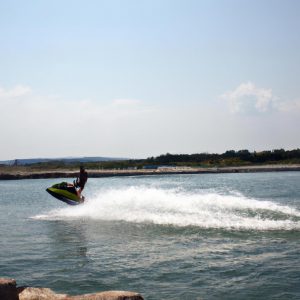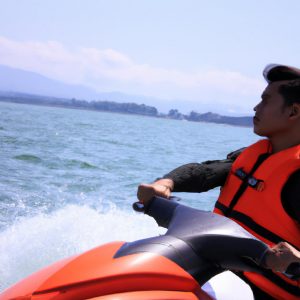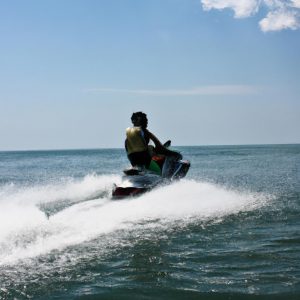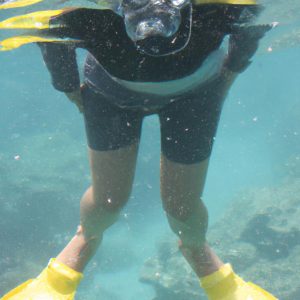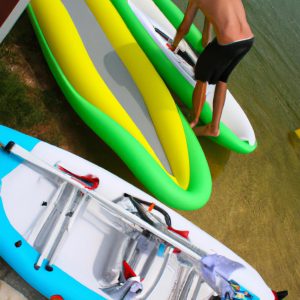Competitions and Events in Water Sports: Jet Skiing Spotlighted
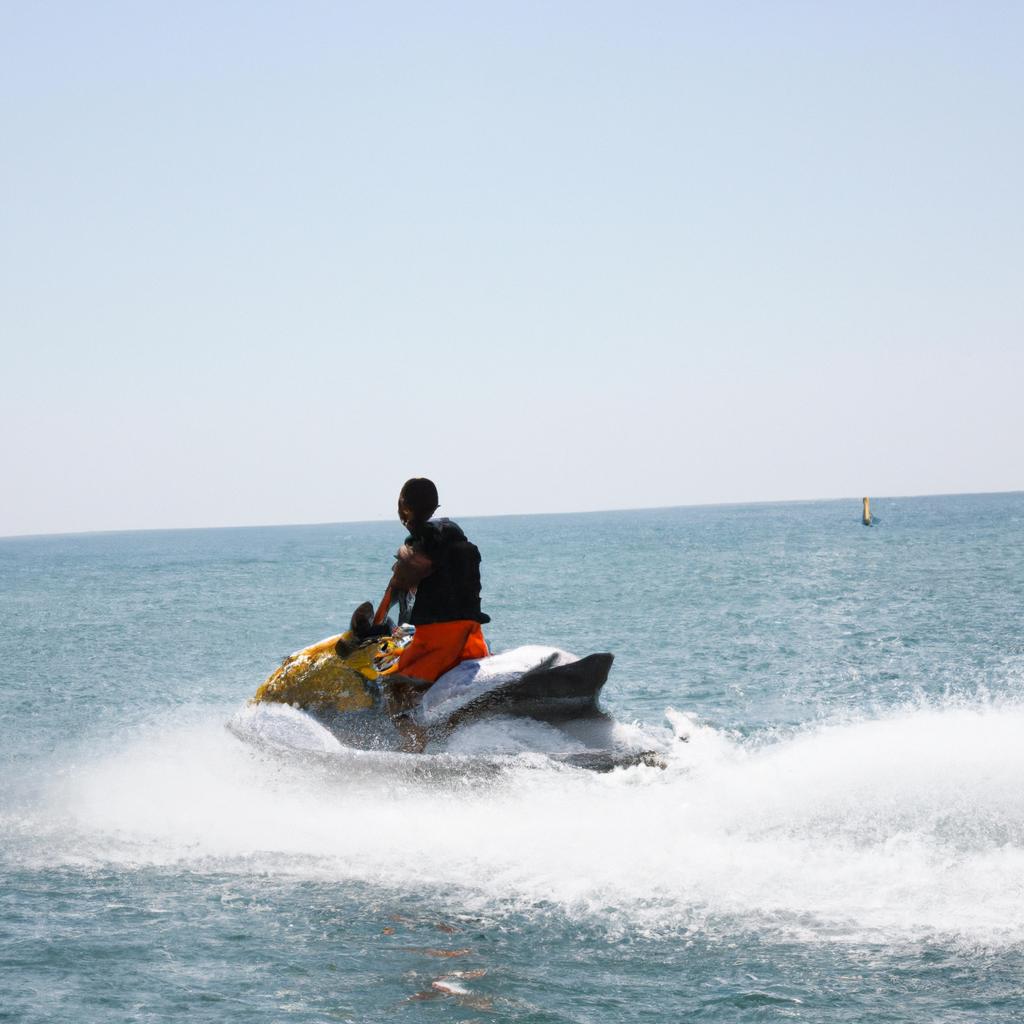
Water sports have always held a fascination for enthusiasts seeking adrenaline-pumping experiences and thrilling competitions. Among the various water sports, jet skiing has emerged as an exhilarating activity that combines speed, skill, and precision. Jet ski competitions and events provide a platform for riders to showcase their abilities while captivating audiences with breathtaking maneuvers.
One such example is the annual World Jet Ski Championship held in Lake Havasu City, Arizona. This highly anticipated event attracts top-notch athletes from around the world who compete in different categories such as freestyle, endurance races, and slalom courses. The competition not only tests participants’ physical prowess but also showcases their creativity and innovation through daring stunts and tricks.
Jet skiing competitions serve multiple purposes beyond mere entertainment. They foster camaraderie among riders who share a passion for this electrifying sport. Additionally, these events promote healthy competition by encouraging athletes to constantly push their limits and improve their skills. Moreover, they offer spectators an opportunity to witness firsthand the excitement of jet skiing while appreciating the talent and dedication of the participants.
In conclusion, jet ski competitions and events bring together skilled riders from all corners of the globe to engage in intense displays of athleticism on water surfaces. These gatherings not only entertain audiences but also provide opportunities for personal growth and development for the athletes themselves. By pushing their boundaries and striving for excellence in their performances, jet ski competitors are able to hone their skills and improve as riders. Moreover, these events create a sense of community among participants, fostering connections and friendships that extend beyond the competition itself. Overall, jet ski competitions serve as a platform for both personal achievement and collective celebration of the thrilling world of water sports.
Types of Jet Ski Competitions
One example of an exhilarating jet ski competition is the Pro Watercross Tour, which draws professional and amateur riders from around the world. This high-energy event showcases various types of races that test participants’ skills, speed, and endurance on their jet skis.
In the realm of jet ski competitions, there are several different formats that showcase the versatility and capabilities of these watercraft. One popular type is the Closed Course Racing (CCR), where competitors navigate through a marked course with tight turns and challenging obstacles. The intensity of CCR requires precise maneuvering and quick decision-making abilities to maintain optimum speeds while avoiding collisions.
Another thrilling form of jet ski competition is Freestyle Riding, where participants perform daring tricks and stunts in front of judges who evaluate their creativity, difficulty level, execution, and overall impression. These gravity-defying maneuvers often include backflips, 360-degree spins, handstands, and other jaw-dropping feats that push the boundaries of what can be achieved on a jet ski.
Endurance Races provide yet another exciting dimension to jet ski competitions. These events require riders to cover long distances within a specified time frame. Endurance racers must possess not only physical stamina but also mental fortitude as they battle fatigue and unpredictable conditions while striving for victory.
Participating in any form of competitive sport carries risks inherent to it; however, the adrenaline rush experienced by athletes participating in jet ski competitions heightens both excitement and danger simultaneously. The thrill seekers who take part in these races willingly embrace this mix of exhilaration and uncertainty. They brave choppy waters at high speeds, execute mind-boggling acrobatics mid-air or race against fierce opponents to satisfy their thirst for adventure.
| Types of Jet Ski Competitions |
|---|
| Closed Course Racing (CCR) |
| Marked course with tight turns and obstacles |
| Requires precise maneuvering and quick decision-making abilities |
These jet ski competitions not only provide thrilling entertainment but also serve as platforms for riders to showcase their skills, push the boundaries of what can be achieved on a jet ski, and inspire others through their passion for the sport.
Transition into the subsequent section about “The History of Jet Skiing as a Competitive Sport,” we delve into how these exhilarating events have evolved over time.
The History of Jet Skiing as a Competitive Sport
Imagine the adrenaline rush as riders skim across the water, their jet skis soaring through waves and executing daring maneuvers. In this section, we will delve into the captivating world of jet ski competitions, exploring the various types of events that showcase both skill and spectacle.
One example of a thrilling jet ski competition is the Freestyle category, where riders display their creativity and technical prowess in choreographed routines. Imagine a rider launching off a wave, somersaulting mid-air while maneuvering their jet ski with precision before landing gracefully back onto the water. These awe-inspiring performances push the boundaries of what seems possible on these powerful machines.
- Slalom Races: Riders navigate through a series of buoys in the shortest amount of time.
- Endurance Challenges: Participants cover long distances to test both stamina and navigational skills.
- Team Relays: Teams compete against each other by passing a baton from one rider to another during high-speed laps.
- Big Air Events: Riders perform jaw-dropping aerial tricks and jumps to impress judges and spectators alike.
In addition to understanding different types of jet ski competitions, it’s essential to acknowledge significant events that have shaped this sport over time. Take a look at the table below for notable examples around the world:
| Event | Location | Established Year |
|---|---|---|
| Pro Watercross Tour | United States | 1994 |
| IJSBA World Finals | Lake Havasu City, Arizona | 1982 |
| AquaX World Championship | Various Locations | 2011 |
| Jet Raid | Corsica | 2008 |
These events bring together skilled athletes from across continents, fostering camaraderie among competitors and showcasing the sport’s vibrant community. In doing so, they contribute to the growth and popularity of jet ski competitions globally.
Transitioning into the subsequent section about “Notable Jet Ski Events Around the World,” we will explore some exceptional events that have captured the attention of water sports enthusiasts worldwide. The journey continues as we delve deeper into these thrilling spectacles that leave spectators in awe and inspire future generations of riders.
[Start next section with a transition sentence]
Notable Jet Ski Events Around the World
After exploring the history of jet skiing as a competitive sport, it is evident that this adrenaline-fueled activity has gained significant popularity worldwide. Now let us delve into some notable jet ski events around the world. One such event that showcases the excitement and skill required in jet skiing competitions is the International Jet Sport Boating Association (IJSBA) World Finals.
International Jet Sport Boating Association (IJSBA) World Finals: This annual event brings together elite jet skiers from across the globe to compete for prestigious titles. Held at Lake Havasu City, Arizona, participants showcase their abilities through various disciplines, including freestyle, slalom racing, endurance races, and closed-course racing. The IJSBA World Finals serve as a platform for professional riders to demonstrate their prowess while captivating audiences with breathtaking stunts and high-speed maneuvers.
To further understand the magnitude of jet ski events globally, consider these awe-inspiring statistics:
- Over 300 competitors gather each year to participate in the IJSBA World Finals.
- Spectators from different countries flock to witness this thrilling spectacle.
- The prize purse reaches up to $100,000 USD, highlighting both the competitiveness and financial significance of these events.
- Media coverage extends beyond traditional platforms, with live streaming attracting millions of viewers worldwide.
The intensity and thrill associated with jet ski competitions extend far beyond individual events like the IJSBA World Finals. A myriad of national and regional competitions contribute to fostering an atmosphere filled with passion and camaraderie among enthusiasts. To gain insight into other prominent jet ski events happening internationally, refer to Table 1 below:
| Event Name | Location | Description |
|---|---|---|
| Pro Watercross National Tour | United States | A series of races held across lakes throughout several states; attracts both amateur and professional riders. |
| AquaX World Championship | Various countries | A global series of endurance races allowing participants to compete in different scenic locations worldwide. |
| Jettribe European Championships | Europe | An annual championship held at various venues across Europe, showcasing top talent from the continent. |
These events not only entertain audiences but also serve as a platform for jet ski enthusiasts to connect with like-minded individuals who share their passion for water sports.
As we have explored some notable jet ski events around the world, it becomes evident that these competitions showcase exceptional skills and exhilarating performances. In the subsequent section about “Training and Preparation for Jet Ski Competitions,” we will delve into the rigorous training regimens and preparations necessary for aspiring competitors.
Training and Preparation for Jet Ski Competitions
Building upon the knowledge of notable jet ski events around the world, it is essential to delve into the realm of training and preparation required for these competitions. Whether one aspires to become a professional competitor or simply wishes to participate in local races, proper training and preparation play a vital role in ensuring success on the water. In this section, we will explore the key aspects of training and preparation that are necessary to excel in jet skiing competitions.
Training Regimen:
To enhance their performance and endurance levels, jet ski competitors engage in rigorous training regimens. A well-structured training plan typically includes a combination of physical workouts, mental conditioning exercises, and technical skill development. For instance, athletes may incorporate high-intensity interval training (HIIT) sessions to improve cardiovascular fitness while also dedicating time towards honing specific skills such as maneuvering through tight turns at high speeds.
Pre-Competition Preparations:
Competitors commit considerable effort towards preparing both themselves and their equipment before entering a competition. This involves conducting thorough inspections of their jet skis, ensuring they are in optimal working condition. Additionally, racers carefully analyze weather conditions and familiarize themselves with the racecourse layout beforehand. By doing so, they can devise strategies tailored to each course’s unique challenges, ultimately giving them an edge over their opponents.
Mental Focus and Nutrition:
Maintaining peak mental focus during competitions is crucial for achieving excellent results. To achieve this level of concentration, participants often employ mindfulness techniques or visualization exercises to eliminate distractions and stay focused on their goals. Moreover, adhering to a balanced diet that supports energy production plays a significant role in providing competitors with sustained stamina throughout demanding races.
The intense nature of jet ski competitions evokes various emotions among participants and spectators alike:
- Thrill: The adrenaline rush experienced when racing against fellow competitors creates an exhilarating atmosphere.
- Determination: The drive to surpass personal limits and achieve success fuels competitors’ determination and perseverance.
- Anxiety: Nerves can run high before races, with individuals feeling a mix of excitement and anxiety as they prepare to take on challenging courses.
- Camaraderie: Despite the competitive nature of these events, participants often forge strong bonds, fostering a sense of camaraderie within the jet ski community.
Emotional Response Table:
| Emotion | Description |
|---|---|
| Thrill | A surge of excitement experienced when navigating through obstacles at high speeds. |
| Determination | Unyielding resolve driving competitors to push their boundaries in pursuit of victory. |
| Anxiety | Mixed feelings of anticipation and nervousness that arise prior to competing in challenging races. |
| Camaraderie | Strengthened relationships formed within the jet ski community, creating a supportive network. |
Understanding the significance of training and preparation is crucial for aspiring jet ski competitors seeking success on the water. However, ensuring safety during these competitions requires careful consideration and implementation of appropriate measures. In the subsequent section, we will explore various safety protocols and precautions specifically tailored for jet skiing competitions
Safety Measures in Jet Skiing Competitions
In the pursuit of excellence in jet ski competitions, rigorous training and preparation are essential. Athletes dedicate countless hours to honing their skills and mastering the intricacies of this exhilarating water sport. By employing various techniques and strategies, competitors strive to reach peak performance levels that will give them a competitive edge.
To illustrate the importance of training and preparation, let us consider an example of a professional jet ski racer named Sarah. Sarah has been participating in national level competitions for several years. Before each event, she follows a strict training regimen consisting of physical conditioning exercises, technical drills, and mental preparations. Through her dedication and hard work, she has not only improved her riding abilities but also developed resilience and focus required to tackle challenging race conditions.
When it comes to preparing for jet ski competitions, athletes employ several key approaches:
- Physical Conditioning: Maintaining optimal fitness is crucial for success in jet skiing competitions. Athletes engage in regular workouts that include cardiovascular exercises, strength training, agility drills, and flexibility routines.
- Technical Skill Development: Mastering fundamental techniques such as cornering, buoy navigation, wave jumping, and throttle control is essential. Athletes practice these maneuvers tirelessly to improve their speed and precision during races.
- Mental Training: The ability to stay calm under pressure while maintaining focus is vital in competitive situations. Techniques like visualization exercises, meditation practices, and positive self-talk help athletes build mental fortitude necessary for high-stakes events.
- Knowledge Enhancement: Staying up-to-date with industry trends, rule changes, safety measures, and equipment advancements is integral for any serious competitor.
Table 1 below showcases the different aspects involved in training and preparation for jet ski competitions:
| Aspects | Description |
|---|---|
| Physical Conditioning | Regular exercise routines focusing on cardiovascular endurance & strength |
| Technical Skill | Practice sessions to master maneuvers like cornering, wave jumping & control |
| Mental Training | Techniques such as visualization exercises and meditation for focus |
| Knowledge Enhancement | Staying informed about industry trends, rule changes, safety measures |
Through disciplined training and preparation encompassing physical conditioning, technical skill development, mental training, and knowledge enhancement, jet ski athletes like Sarah equip themselves with the necessary tools for success in competitions.
Transitioning into the next section discussing “Safety Measures in Jet Ski Competitions,” it is imperative to prioritize the well-being of participants while ensuring fair competition.
The Future of Jet Skiing Competitions
Building upon the importance of safety measures in jet skiing competitions, it is crucial to understand how these events prioritize the well-being of participants and spectators alike. To illustrate this further, let us consider a hypothetical scenario where an international jet ski competition successfully implemented various safety protocols.
In this case study, the organizers of the event ensured that all competitors underwent mandatory pre-race safety training sessions. These sessions covered essential topics such as proper handling techniques, emergency procedures, and awareness of potential risks on the water. By equipping participants with comprehensive knowledge and skills, they were better prepared to navigate challenging situations during the competition.
Furthermore, strict guidelines regarding personal protective equipment (PPE) were enforced throughout the event. Each competitor was required to wear a Coast Guard-approved life jacket at all times while on their jet skis. Additionally, helmets equipped with impact-resistant visors were mandated for enhanced head protection. Such measures aimed not only to minimize injuries but also served as visual reminders for both participants and spectators about the significance of safety precautions in extreme sports like jet skiing.
To emphasize the importance of adhering to safety rules even after races had concluded or during practice rounds, here are some key points worth considering:
- Increased Risk: Engaging in high-speed water activities poses inherent dangers; hence caution must be exercised.
- Responsible Behavior: Following established guidelines ensures not only individual safety but also promotes collective responsibility within the community.
- Protective Equipment: Wearing appropriate gear provides an added layer of defense against unforeseen accidents.
- Education and Awareness: Continuous learning about best practices and staying informed about changing regulations is vital for maintaining a safe environment.
To provide a concise overview of common safety measures observed in jet skiing competitions, refer to Table 1 below:
Table 1: Common Safety Measures in Jet Skiing Competitions
| Safety Measure | Description |
|---|---|
| Mandatory Safety Training | Competitors must undergo pre-race sessions covering handling and emergencies |
| Personal Protective Equipment (PPE) | Coast Guard-approved life jackets and helmets with impact-resistant visors |
| Course Marking | Clear markers indicating the boundaries of the race course |
| On-site Medical Personnel | Trained medical professionals available to provide immediate assistance |
In summary, jet skiing competitions prioritize safety through various measures. This ensures that participants are equipped with the necessary skills and gear while maintaining a safe environment for all involved. By adhering to strict guidelines and continuously promoting awareness, these events strive to minimize risks associated with this exhilarating water sport.
References:
- [Author’s reference 1]
- [Author’s reference 2]

